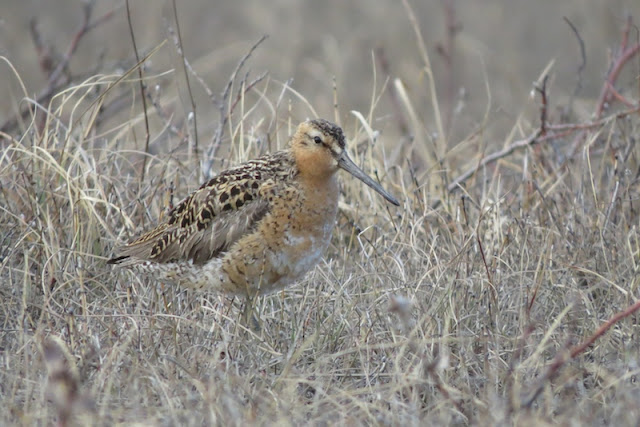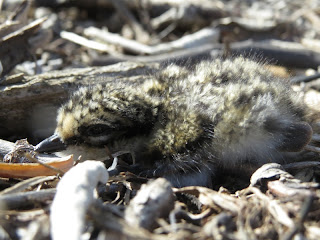From June 6 until July 12 I lived in a tent on Fish Island in the Northeastern portion of the Mackenzie Delta - a mere 10km from the Beaufort Sea. I was volunteering for the Canadian Wildlife Service where I joined 4 others to carry out research focused on shorebirds. Our main tasks involved hiking around designated areas looking for shorebird nests and banding as many shorebirds as we could.
On June 6th we were dropped off to our island by helicopter. Due to the location of the camp we did not know what the conditions were like before heading out. Turns out that the area was almost entirely flooded. Another 10cm of water would have resulted in absolutely no land for the helicopter to drop us off.
This is what it looked like at that time:
Note the igloo shaped permanent 'building'. That's where our camp is.
Within 3 days the water had receded enough for us to walk over 3km to the South and East.
The habitat on Fish island consisted almost exclusively of low-centre polygons. They are a really cool natural phenomenon characteristic of the arctic. You can see the ridges of the low-centre polygons in this photo taken on July 10 from near our camp:
For multiple reasons, shorebirds love this habitat for breeding. In the areas we surveyed, there were 11 species of breeding shorebird. Following are the 5 species of shorebirds that we primarily worked with:
In total we found 3 Hudsonian Godwit (HUGO) nests. We managed to place satellite transmitters on 2 male HUGOs, and 1 female HUGO. These are the first HUGO's to ever have satellite transmitters placed on them. I will be sure to update my blog with their migration routes... which has already begun!
We found several Whimbrel (WHIM) nests, and placed satellite transmitters on 3 WHIMs, as well. WHIM's have an unusual habit of nesting in the most conspicuous locations imaginable and seem to make no effort to conceal their eggs, making them an easy target for aerial predators. Of the 8 WHIM nests that we found, only 2 survived until the time we left. Two of the three WHIMs that we placed satellite transmitters are already over 1000km from where we banded them!
Our camp at the Mackenzie Delta is part of the international Arctic Shorebird Demographic Network (ASDN). There are several camps, mostly in Alaska and arctic Canada, and all of them focus their efforts on 3 species: Semipalmated Sandpipers, Red-necked Phalaropes, and Pectoral Sandpipers.
The most abundant shorebird in our area were Red-necked Phalaropes (RNPH). Phalaropes are unusual in that the female is more brightly coloured and do not incubate the eggs, nor do they raise the chicks. The females leave the males behind after laying their eggs.
This pair of Phalaropes went on to make a nest that had only 2 eggs. Most, if not all, shorebirds lay 4 eggs in a nest indicating that this female already had a nest with another male, or left the male after only 2 eggs for whatever reason:
The males are most easily distinguishable from females by their less colourful throat and neck. Although, from my observations there seemed to be a spectrum of dull to bright males, and dull to bright females that probably involved a bit of overlap.
RNPH chicks are probably the cutest non-plover chicks!

Semipalmated Sandpipers (SESA) did not breed on Fish Island (our home island), but there were other islands within reach of our boats that had suitable habitat for this species.
Both males and females take part in incubating and raising the chicks.

Their nests were very well concealed in the tundra habitat making them extremely difficult to re-find! This nest has the expected 4 eggs:
Our group was tasked with deploying 15 geolocators on Semipalmated Sandpipers. This SESA has been banded with a geolocator by me. The hope is that these SESA's will return to the same location next year to breed so that they can be re-trapped and the geolocators removed so that the data can be accessed! Realistically, we'll be lucky if 1 or 2 of these birds is ever re-trapped on the breeding grounds because the SESA's in our area do not seem to have nest site fidelity.
The third target species, Pectoral Sandpiper (PESA), were common on our island during the first 1-2 weeks. The males could be heard performing their 'booming' displays from over a kilometer away - a very fascinating display. However, the females, and their nests are much more difficult to track down. In previous years, the crew at the Mackenzie Delta were lucky to find 1 or 2 nests. This year we managed to find 9, which probably indicates a good breeding season for this species rather than a stellar crew! :p

We banded 3 PESA chicks, here are 2 from one family:
By the end of the season our group banded almost 150 shorebirds, and found about 110 shorebird nests! Previous years at our location never broke the 100 mark for shorebirds banded, or nests found. Clearly, the abundance of nesting shorebirds was good this year in our area.
And, not surprisingly, wherever there are plenty of shorebirds, there are predators...
... to be continued ;)























































